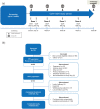Ocrelizumab treatment for relapsing-remitting multiple sclerosis after a suboptimal response to previous disease-modifying therapy: A nonrandomized controlled trial
- PMID: 34382875
- PMCID: PMC8978461
- DOI: 10.1177/13524585211035740
Ocrelizumab treatment for relapsing-remitting multiple sclerosis after a suboptimal response to previous disease-modifying therapy: A nonrandomized controlled trial
Abstract
Background: Many patients with multiple sclerosis (MS) experience suboptimal disease control despite the use of disease-modifying therapy (DMT).
Objective: To assess the efficacy and safety of ocrelizumab (OCR) in patients with relapsing-remitting MS (RRMS) and suboptimal response to prior DMTs.
Methods: Patients with RRMS and suboptimal responses (one clinically reported relapse and/or lesion activity) after ⩾ 6 months on another DMT were enrolled. OCR 600 mg was given intravenously every 24 weeks. The primary outcome was no evidence of disease activity (NEDA), defined as the absence of protocol-defined relapse, confirmed disability progression (CDP), T1 Gd-enhancing lesions, and new/enlarging T2 lesions.
Results: The intention-to-treat (ITT) population included 608 patients; NEDA was analyzed in a modified ITT (mITT) population (n = 576 (94.7%)). Over 96 weeks, 48.1% of mITT patients achieved NEDA, and most were free from protocol-defined relapse (89.6%), CDP (89.6%), and T1 Gd-enhancing lesions (95.5%); 59.5% had no new/enlarging T2 lesions. Safety observations were consistent with findings in the pivotal trials.
Conclusion: Consistent efficacy of OCR on clinical and magnetic resonance imaging (MRI) disease activity measures and progression was shown in patients with RRMS and a suboptimal response to prior DMTs; no new safety signals were observed.
Keywords: MRI; Multiple sclerosis; disease progression; ocrelizumab; safety; switch.
Conflict of interest statement
Figures

References
-
- Wingerchuk DM, Carter JL. Multiple sclerosis: Current and emerging disease-modifying therapies and treatment strategies. Mayo Clin Proc 2014; 89(2): 225–240. - PubMed
-
- Gross RH, Corboy JR. Monitoring, switching, and stopping multiple sclerosis disease-modifying therapies. Continuum 2019; 25(3): 715–735. - PubMed
-
- Bermel RA, You X, Foulds P, et al.. Predictors of long-term outcome in multiple sclerosis patients treated with interferon beta. Ann Neurol 2013; 73(1): 95–103. - PubMed
-
- Rio J, Comabella M, Montalban X. Predicting responders to therapies for multiple sclerosis. Nat Rev Neurol 2009; 5(10): 553–560. - PubMed
-
- Ziemssen T, De Stefano N, Sormani MP, et al.. Optimizing therapy early in multiple sclerosis: An evidence-based view. Mult Scler Relat Disord 2015; 4(5): 460–469. - PubMed
Publication types
MeSH terms
Substances
LinkOut - more resources
Full Text Sources
Medical

